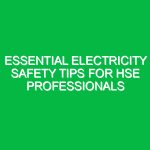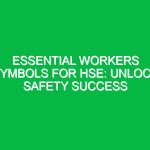Introduction
Hello team! Today, we’re conducting a toolbox talk focused on a crucial aspect of our daily operations: Overhead Hazards. As we prepare to start our work, it’s imperative to understand the risks associated with overhead Hazards and how we can effectively mitigate them. By being aware and prepared, we enhance not just our Safety but also the Safety of our colleagues. This talk will provide you with essential information, practical tips, and insights on overhead hazards in the Health, Safety, and Environment (HSE) context.
What Are Overhead Hazards?
Overhead hazards refer to any potential dangers that exist above the work area. This can include anything from suspended loads, overhead equipment like cranes and hoists, to anything that could fall from above, such as tools, materials, or debris. Understanding these hazards is vital in preventing accidents and ensuring a safe working environment.
Why Are Overhead Hazards Important?
Overhead hazards pose significant risks that can lead to serious injuries or even fatalities. According to the Occupational Safety and Health Administration (OSHA), a considerable percentage of workplace injuries result from falling objects. By recognizing and addressing these hazards, we can significantly reduce the risk of accidents. Let’s explore some common types of overhead hazards you might encounter:
- Falling Objects: Tools, materials, or debris that can drop from above.
- Suspended Loads: Loads that are being lifted or moved overhead, which can shift unexpectedly.
- Overhead Equipment: Cranes, hoists, and other machinery that can malfunction or pose risks.
Identifying Overhead Hazards
Before we begin our tasks, it’s essential to identify potential overhead hazards. Here are some tips to help you effectively spot these dangers:
- Conduct a Site Walkthrough: Always perform a thorough walkthrough of your work area before starting. Look up and assess the surroundings for any overhead risks.
- Use Your Senses: Listen for unusual sounds that may indicate falling objects or equipment malfunctions. Look for signs of wear or damage on equipment.
- Consult with Your Team: Communicate with your coworkers about any observed hazards. Two sets of eyes are always better than one!
Real-Life Scenario
Let’s consider a situation that highlights the importance of identifying overhead hazards. Imagine a construction site where a worker is lifting materials using a crane. If the worker does not check for overhead power lines or other equipment first, they could accidentally cause an accident, leading to severe injuries or even fatalities. Always remember, proactive identification of risks can save lives.
Best Practices for Managing Overhead Hazards
Now that we understand what overhead hazards are and how to identify them, let’s talk about some Best Practices to manage these risks effectively.
1. Use Proper Personal Protective Equipment (PPE)
Wearing the right PPE is crucial when working in areas with overhead hazards. This includes:
- Hard Hats: They protect your head from falling objects.
- Safety Glasses: Protect your eyes from debris.
- Steel-Toed Boots: Offer protection to your feet in case of a falling object.
2. Maintain a Safe Distance
Keep a safe distance from areas where overhead work is taking place. This is particularly important when loads are being lifted or moved overhead. Establish a clear exclusion zone and ensure that all workers are aware of it.
3. Secure Tools and Materials
Ensure that all tools and materials are secured when working at heights. Use tool lanyards and ensure that materials are stored properly to prevent them from falling. For instance, at the end of each workday, check that all items are stowed safely.
4. Implement Effective Communication
Establish clear communication protocols with your team. Use hand signals or radios to communicate when overhead work is in progress. Let’s say a crane operator is lifting materials; they should communicate with ground personnel to ensure everyone is aware and safe.
Regulations and Standards
Understanding the Regulations surrounding overhead hazards is vital for compliance and safety. osha has established several standards that govern overhead work and safety practices. Here are some key regulations to keep in mind:
- OSHA Standard 1926.502: This standard outlines Fall Protection requirements for employees working at heights.
- OSHA Standard 1926.550: This standard provides regulations for cranes and derricks in construction.
- Company Policies: Familiarize yourself with your company’s safety policies regarding overhead work.
Why Compliance Matters
Adhering to these regulations is not just a legal obligation; it’s a moral one. Compliance ensures a safer workplace and reduces the likelihood of incidents. It also protects the company from potential fines and legal issues.
Actionable Insights for Daily Operations
As we conclude our toolbox talk, here are some actionable insights you can implement right away:
- Daily Check-Ins: Before starting work, conduct a brief team meeting to discuss potential overhead hazards for the day.
- Regular Training: Participate in ongoing safety training that focuses on overhead hazards and Safe Practices.
- Encourage Reporting: Foster an environment where employees feel comfortable reporting hazards without fear of repercussions.
Open Discussion
Now, let’s open the floor for questions or experiences you may want to share. Have any of you encountered a situation involving overhead hazards? How did you manage it? Your insights could help others avoid similar situations!
Conclusion
In summary, understanding and managing overhead hazards is crucial for maintaining a safe work environment. By identifying risks, following Best Practices, and adhering to regulations, we can significantly reduce the chances of accidents. Remember, safety is a shared responsibility, and each one of us plays a vital role in creating a safe workplace.
Thank you for your attention and commitment to safety. Let’s work together to ensure we all return home safely at the end of the day!


